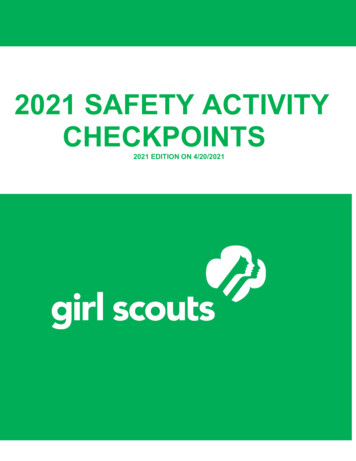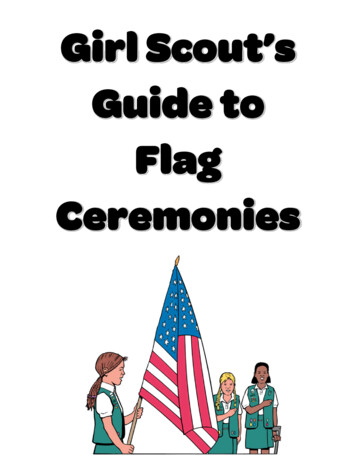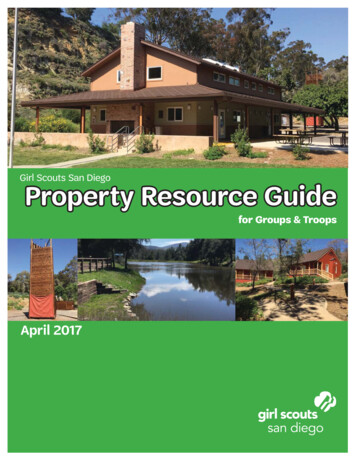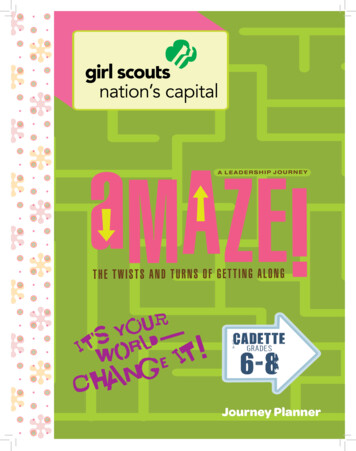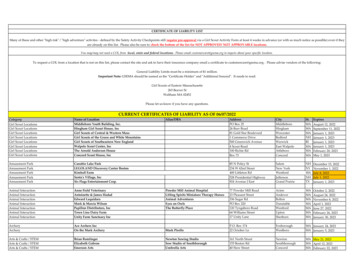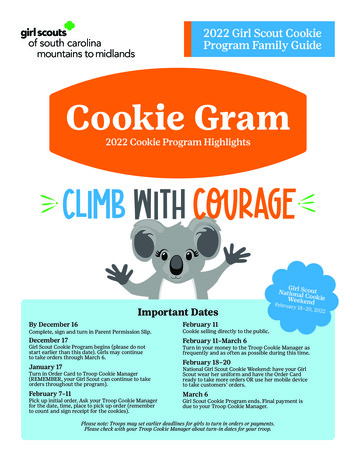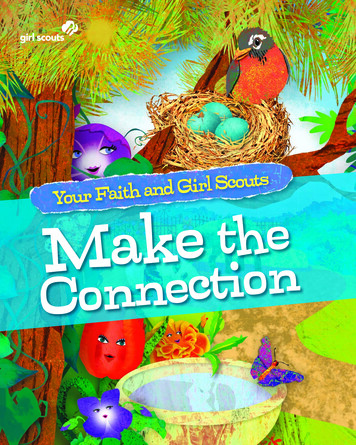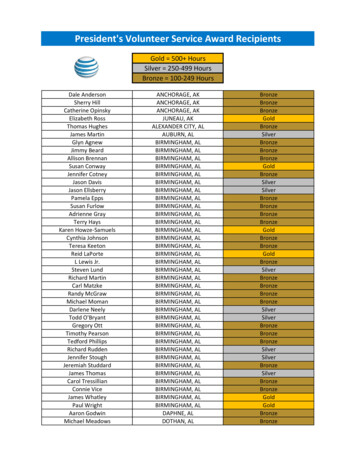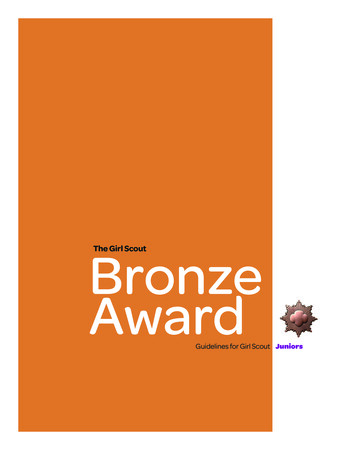
Transcription
BronzeAwardThe Girl ScoutGuidelines for Girl Scout JuniorsBronze Award.indd 13/4/11 2:09 PM
Girl GuidelinesWelcome to the Girl Scout Bronze Award, a leadership adventure for youand more than half a million other Girl Scout Juniors across the countryand around the world. Imagine what you can accomplish when you teamup with others and use your special skills and interests to take action andmake a difference in the world!As you can tell, this Girl Scout Bronze Award adventure is big—in fact, this award is thehighest honor a Girl Scout Junior can achieve. As you and your team plan and complete your project, you’ll develop more confidence, meet new people, and have thekind of fun that happens when you work with other Girl Scouts to make a difference.Here are the steps you’ll take to earn your Girl Scout Bronze Award:1.Go on a Girl Scout Junior Journey.2.Build your Girl Scout Junior team.3.Explore your community.4.Choose your Girl Scout Bronze Award project.5.Make a plan.6.Put your plan in motion.7.Spread the word.When you go for the Bronze Award, you represent what Girl Scouts can achieve intheir communities. And, of course, you want to do that in a way that’s fun for you—and for everyone else involved, too! Earning the Girl Scout Bronze Award involvesthe time to complete a Journey, and then a suggested minimum of 20 hours building your team, exploring your community, choosing your project, planning it, putting your plan in motion, and spreading the word about your project. The suggestedhours help you think about your commitment to doing your very best with eachstep. That’s different for every Girl Scout, so these hours aren’t a rule, just a friendlyreminder. You’re a Girl Scout, which means you will earn your award with courage,confidence, and character and make a difference in the world around you!Step1Step 1: Go on a Girl Scout Junior JourneyThe first requirement for earning the Girl Scout Bronze Award is completing a GirlScout Journey. If you haven’t done one yet, now’s the time! Most girls say they spendthree or four months on a Journey, but that’s not a rule: Take all the time you need.When you’ve finished your Journey, you’ll have earned three special leadershipawards. Set aside some time to think about all you learned and accomplished.Here are some questions you might want to think about: How did you use the values of the Girl Scout Law during yourGirl Scout Junior Journey? What did you Discover about yourself? Who did you Connect with? How did you Take Action, and what did you learn?Then take your next step:Creating your very own Girl Scout Bronze Award adventure.2Bronze Award Rev2.indd 24/21/11 5:13 PM
The Girl Scout Bronze AwardStep2Step 2: Build Your Girl Scout Junior TeamWhat’s a Girl Scout Junior team? That’s you and other Girl Scout Juniors who areon this adventure together, plus your troop/group volunteer. If there are no otherGirl Scout Juniors in your neighborhood, seek out some friends your age—they caneven join Girl Scouts and earn the award with you! More girls equal more friends,more ideas, and more ways to make a difference.After you’ve built your team, hold a meeting, and spend some time getting to knoweach other. After all, making new friends is one of the fun parts of being a Girl Scout!You could start by playing a game, perhaps one that you played on your Girl ScoutJunior Journey, at summer camp, or at school. Of course, if you’re working withother girls in your troop, you already know each other quite well. Even so, you probably don’t know everything about each other. You might be surprised at what youlearn about girls you’ve known since kindergarten!It’s also a good idea to think about what you each enjoy doing the most.Soon, your team will explore and choose an idea for a Take Action project.Keep handy your team’s list of what each member loves to do; it will helpyou in a few ways: You’ll know the special talents each of you can bring to the projectyou choose. You’ll learn more about each team member so that you can be agreat Take Action team. You may even touch on something that becomes the beginning of anidea for a Take Action project!Here are some questions to help you pinpoint your interests: Do you read everything you can get your hands on—even the back ofthe cereal box? Do you love playing with your pets? Do you spend hours painting, singing, or dancing? Are you always in motion—riding your bike, surfing, or playing soccer?Really spend some time thinking about all the things you love to do, from conductingscience experiments to taking care of younger kids to whipping up fruit smoothiesfor your friends!At the end of your first meeting, talk about what everyone thinks the group shoulddo to be a great team, like “listen to others without interrupting” or “help out at eachmeeting.” Write the suggestions on a large piece of paper, and post it on the wallwhenever you have team meetings.B R O N Z E AWA R DBronze Award Rev2.indd 334/21/11 5:13 PM
Girl GuidelinesStep3Step 3: Explore Your CommunityThere are many ways to make a difference, so what’s the best project idea for yourteam? One that you come up with yourselves, of course! How can you do that? Thefirst step is to take a close look at what’s going on right around you. Maybe you haveideas from when you did your Girl Scout Junior Journey—was there a project youdidn’t have time for that you could work on now?Start by exploring your community: your block, your neighborhood, or your school.As you walk or bike around town, keep your eyes open for ways you can make a positive change. As you take a bus to school or ride in the car with your parents, look forproblems that should be fixed. (You might even spot something that could makeeveryone’s daily ride on the school bus a little bit better!) As you spend the day inschool, take note of how things could be improved.Here are a few tips: In addition to observing on your own, you can make this a teamactivity. Get together as a group to walk around your school or yourblock, talking about what you see. Keep a notebook handy to jot down what you see, plus any ideasabout possible projects. Keep an open mind as you look around! Sometimes, ideas comefrom seeing a problem that needs to be fixed, such as peoplewasting paper in your school. Sometimes they come from seeinga chance for improvement, such as painting a wall mural thatcelebrates your neighborhood’s history. Feeling stuck? Think about something that would make your lifebetter; chances are, other people have that same idea! For example,maybe you’d like to exercise more because you know it will makeyou healthier, but you don’t know how to get started. Other peoplemight feel the same way. How about creating a “Let’s Move It!”club that meets once a week after school? You can jump rope, playhopscotch, run races—anything that keeps you active!The following Observation List is a great way to keep track of your observations.Write your observations in the left-hand column, and then write your possiblesolutions in the right-hand column. A few examples are listed to get you started.After you have filled in your chart, circle the three ideas that matter most to you.But don’t worry if you don’t have many “Maybe We Could” ideas yet. The importantthing is to identify what you care about and want to take action on.4Bronze Award.indd 43/4/11 2:09 PM
The Girl Scout Bronze AwardObservation ListObservationWhat do you see and hear around you? Hereare ideas for what to look out for.Maybe We Could Possible project ideas to make a difference.Our Girl Scout meeting space isn’t very“green,” and we’d also like to make the spacemore fun for younger Girl Scouts.Add fun decorations that are also “green,”and figure out how much energy we use during our meetings.A recent flood damaged more than 100homes in town.Find out how people prepare for floods; thinkof ways to share what we learned.Add your own . . . what else do you observe inthe course of a day in your life?B R O N Z E AWA R DBronze Award Rev2.indd 554/21/11 5:13 PM
Girl GuidelinesHere are a couple of examples to show how an observation led to a Take Actionproject (Steps 4–6 will give you more tips about how to do the same thing yourself):Example #1Lucia and her Junior team were going after their Girl Scout Bronze Award, so theyall agreed to be extra observant of everything going on around them. Here’s whatLucia observed and how it turned into their Take Action project:1.First, Lucia noticed that cars whizzed down the street near their school. Thishappened a few days in a row—it seemed to be a real problem.2.Then, she heard on the news that in the last year there had actually been several accidents in that same area.3.The Junior team asked their troop/group volunteer to help them find outhow people in their community decided where stop signs were needed.4.After a visit to both the police station and a local government office, here’swhat the Juniors did: They wrote a petition asking for a new stop sign on theroad near their school, got local residents to sign it, and then presented it totheir local government officials. Result: A new stop sign, slower traffic, feweraccidents, and safer kids! Plus, a stop sign is a permanent solution!Example #2Tanya and her Junior team also decided to be extra observant for a week or two.When they got together to share what they observed, Tanya asked her friends,“Have you ever noticed how hard it is for older people or people with disabilitiesto get around the grocery store?” The team agreed that this was a problem thatno one seemed to be addressing. It seemed like a good challenge for their team!Here’s what they did:1.First, they decided to visit the store together and just watch as peopleshopped. This convinced them that some people could use a little extra help.2.Then they met as a team and brainstormed how they could help and howthey could explain their project idea to the store manager.3.Next, they met with the store manager. Here’s what happened next: The girlsgot permission to team up during the peak holiday season and offer theirassistance to shoppers. Sometimes they would take a person’s grocery listand go up and down the aisles to get products. Other times, they would walkaround the store with people and help them fill their baskets. In both cases,they helped people get through the checkout line and out to their cars. Tokeep this project going, they wrote a tip sheet about how other youth andvolunteer groups can do the same thing.6Bronze Award.indd 63/4/11 2:09 PM
The Girl Scout Bronze AwardStep4Step 4: Choose Your Girl ScoutBronze Award ProjectNow that you’ve observed what’s going on in your community, here are some stepsto take in order to choose your Girl Scout Bronze Award project:1.Meet with your team to share what you’ve seen. You might find that many ofyou noted the same problems or ideas. Your troop/group volunteer can helpyou make a list of the top observations from all the girls on the team.2.Brainstorm ideas about where you can make a difference, based on whatyou’ve seen. Once you have a list that everyone likes, work together tochoose the top three topics that interest everyone the most.3.Now that you’ve come up with your top ideas, you need to get more information so you can understand how you can best help make a difference. Hereare a few tips to get you started on your fact-finding mission: To really understand a problem, you need to get information frommany places—talking to different people, reading newspaper andmagazine articles, and doing research at the library and on theInternet. (Remember to first sign the Girl Scout Internet SafetyPledge in the Badges section of your Girl’s Guide.) This may seemlike a lot of work, but don’t worry, you can share the jobs—afterall, that’s what teams are for! One person can go online to readnewspaper articles, someone else can volunteer to check out booksfrom the library, and so on. Brainstorm with your team and your troop/group volunteer aboutwhere to get more information. You can also visit the library and talkto the librarian. That’s a great way to get suggestions of who to talkto—and get ideas for a great project. It can be hard to talk to adults, especially if you don’t already knowthem! Talk about your ideas with your teachers and neighbors first—you’ll start to feel more confident about asking questions of otheradults. And remember that you’ll be with other members of yourteam as you talk to adults, and that always helps! Take notes about what you learn as you do your research. A blankProject Idea Chart is included at the end of this guide for you towrite down who you talked to, what you learned, and your ideas forthe kind of project you can create. Here are a few project ideas—take a look, and then add your own in the blank Project Idea Chart atthe end of this guide!B R O N Z E AWA R DBronze Award Rev2.indd 774/21/11 5:13 PM
Girl GuidelinesProject Idea ChartObservationOur Girl Scoutmeetingspace isn’tvery “green,”and we’d alsolike to makethe spacemore fun foryounger GirlScouts.Who WeTalked ToWhat WeLearnedOther GirlScouts andtheir families,includingyounger GirlScoutsWe can turndown the airconditionerand add plantsto make ourspace “greener.”The owner of alocal hardwarestoreYounger GirlScouts wouldlike to helpdecorate ourspace.Maybe We Could.Have a family workday wheneveryone can come together toclean and paint.Post photos of Girl Guidesand Girl Scouts from aroundthe world.Turn down the air conditioner oruse fans.Work with younger Girl Scoutsto create a colorful paper mural.Everyone’s interested in seeing what girls inother countrieslook like.A recent flooddamagedmore than100 homes intown.An emergencymedical technician (EMT)A firefighterA Red CrossofficialFamilies whohad damagedhomesMany familiesaren’t preparedfor disasterssuch as floods,hurricanes,and tornados.Everyoneshould beaware of thesteps to takein order tostay safe.Do presentations on disasterpreparedness at school andplaces of worship.Include a simple first-aid-skillssession and a discussion aboutthe impact of natural disastersaround the world.Hand out flyers that list whatfamilies should include in homeemergency kits.8Bronze Award.indd 83/4/11 2:09 PM
The Girl Scout Bronze AwardUse the Project Idea Chart at the back of this guide to explore your top ideas. Oncethe chart is complete, it’s time to choose your project.Look at how much you’ve already learned! Now your Girl Scout Junior team canstart narrowing your three ideas to one. Before you decide, answer these all-important questions about each of your ideas: Why does this idea matter? Who will this idea help? What can we do to make a difference? Is that realistic?Write down your final choice here:As a Girl Scout, you’re a member of the worldwide community. Once your team haschosen a project idea, take some time to talk about how people in other parts of theworld might address the same problem. This doesn’t mean that you have to solvea worldwide problem! However, when you’ve finished your project, you may wantto think of ways to tell your story to people in other places so they can learn aboutwhat you did.B R O N Z E AWA R DBronze Award.indd 993/4/11 2:09 PM
Girl GuidelinesStep5Step 5: Make a PlanNow that you’ve chosen an idea, it’s time to make a plan. It’s always good to thinkbefore you take action. That way, you can aim for success! The following questionshelp you think through your plan before you get started. Also, remember to go backto your Journey(s) for other great tips on project planning!As a team, answer these questions: What is our goal for the project? (If you’re tackling a big issue,narrow your focus to just one part of the problem. That will makeyour goal easier to achieve.) What steps do we need to take to reach our goal? What special talents can each girl use to help make the project asuccess? What did we learn when we did our Girl Scout Junior Journey thatwill help make this project run smoothly? Who can we ask for help? How can we get other people involved? What supplies will we need? Do we need to earn money for our project or can we get donationsfrom people? If we do need money, how can we earn it—or how canwe change the project so that it doesn’t cost anything? Can we usethe money from our cookie sales to fund our project? How much time do we need to finish our project? Is that realistic?Once you have some idea of your plan, ask yourselves if there’s anything you canadd or adjust that will help make a difference even after your project ends. Forexample, if your project helps your school, maybe a teacher, principal, or PTAmember would agree to do it again next year.Here’s an example of how a team made sure their project lasted: Alina and herteam wanted to make new students feel more at home at her school, so theyorganized a “Get to Know You” day. It was a success, but it won’t help students whocame to the school after “Get to Know You” day. To make their plan last longer, Alinaand her team decided to start a student-run “What a Pal!” buddy program for newstudents. They ran the program until they graduated, and then they asked the principal to continue the program after they left the school. That way, new students willalways have a friend, no matter when they move to the school.Now that you’ve answered these questions, take a step back. Does it sound like youhave a good plan? How do you know? Don’t worry, you’ll have plenty of help. Yourtroop/group volunteer is always there to help you and answer questions.Tip: You and your team may want to sit down with your troop/group volunteerand go over your plan one last time before you begin, just to make sure yourplan is realistic. You may need to adjust it slightly before you start. That willmake reaching your goal a little smoother.10Bronze Award.indd 103/4/11 2:09 PM
The Girl Scout Bronze AwardBefore you move on to the next step, fill in the following sentences. This will help youtalk about your project to other people as you start putting your plan into motion.We will make a difference by.We hope our project will help.When we’re done, we’ll know we made a difference because.Step6Step 6: Put Your Plan in MotionNow that you have an overall plan, it’s time to create a list of tasks and deadlinesand figure out who will be doing what. Remember, you’re a team, so one or moregirls can volunteer for each task. Decide when each task needs to be finished. Thenwrite all the information in a Planning Chart like the one that follows. (There is ablank Planning Chart at the end of this guide for you to use.)Planning ChartWhat Is the Task?How Will theTask Be Done?Gather information aboutpreparing for a flood, tornado,or hurricane.Do research onthe Internet or atthe library.When ShouldThis Task BeFinished?Which TeamMember(s)Will Completethe Task?October 17Alina and LeahMariah,Carole, AnnaInterviewemergencyworkers.Create sample homeemergency kits.Use researchto make a listof what shouldbe in the kit; getdonations fromfamilies or thelocal hardwarestore.November 14Tasha, Orna,Michelle,PatriceB R O N Z E AWA R DBronze Award Rev2.indd 11114/21/11 5:13 PM
Girl GuidelinesWhen your list is complete, it’s time to get started. Talk as a team about your progress. You might have to be flexible and switch assignments around or add moretasks—that’s good teamwork.Keep a record of what you’re doing! Take photos, shoot video, or draw picturesalong the way. These will help you share your story when you’re done.Step7Step 7: Spread the WordCongratulations! You and the Girl Scout Junior team have created and carried out aproject that makes a difference in the world around you! Great job! Now it’s time tothink about what you did, why it mattered, and what you learned.First, thank everyone who helped you. They’ll be glad to hear what you wereable to accomplish with their help!Second, put your story together so that you can share it. You’ll be able toshow what you learned, and your story may help others! Here are a few tips forcapturing and sharing your story: Organize your story by answering these questions: How did you decide what was needed in your community? What did you discover about yourself from this experience? How did your team work together? What problems came up? How did you solve them? What leadership skills did you use? What did you do to inspire others to act? How do you feel you and your team have made the world a betterplace? How did you live out the Girl Scout Promise and Law? Be creative in the way you tell your story! Make a photo collage, puttogether a scrapbook, create a short film, or write a play about whatyou did and what you learned. Think about who you can inspire to make a difference—maybeyounger Girl Scouts, students at your school, or other girls aroundthe world. Then decide how you want to tell your story. Maybe youcan post your collage or film online with the help of your troop/group volunteer. Perhaps you could present your project at thecommunity meeting, perform your play at school, or donate yourteam scrapbook to the local library.Finally, be sure to celebrate what you’ve done. Not only have you had a greatadventure, but you’ve helped create a better world!12Bronze Award.indd 123/4/11 2:09 PM
The Girl Scout Bronze AwardProject Idea ChartObservationWho WeTalked ToWhat WeLearnedMaybe We Could B R O N Z E AWA R DBronze Award.indd 13133/4/11 2:09 PM
Girl GuidelinesPlanning ChartWhat Is the Task?How Will theTask Be Done?When ShouldThis Task BeFinished?Which TeamMember(s)Will Completethe Task?14Bronze Award Rev2.indd 144/21/11 5:13 PM
Keep a notebook handy to jot down what you see, plus any ideas about possible projects. Keep an open mind as you look around! Sometimes, ideas come from seeing a problem that needs to be fixed, such as people wasting paper in your school. Sometimes they come from seeing a chance for improvement, such as painting a wall mural that

